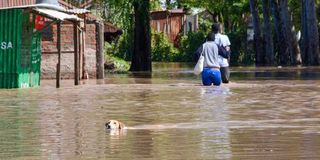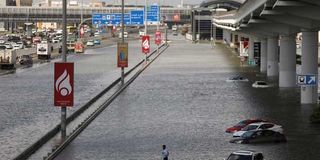Year of Extremes

Residents of Ahero town, Nyando Sub-County, wade through floodwaters on November 29, 2024. Homes have been flooded as water levels in the Nyando River have surged. Photo| Alex Odhiambo
What you need to know:
- If Hidaya had made a landing in Kenya, it would have been a first! It's like spotting a lion strolling on the streets of Nairobi–unexpected and a tad out of place
- At COP29 in Baku, Azerbaijan, the WMO released the State of the Climate 2024. Again, it is a red alert. The world is becoming hotter
- In Mai Mahiu, flash floods killed over 70 people in just one day
BY LILYS NJERU AND HELLEN SHIKANDA
Ordinarily, 2024 is just a number, another year ticked off the calendar. But as we step into 2025, it’s clear that this was no ordinary year. Globally, the impacts of climate change were undeniable, from record-shattering heatwaves to devastating floods that left scores dead and lives upended. Glaciers shrank, and the sea levels crept even higher. Here in Kenya, the climate narrative unfolded with its distinct chapters, from erratic rainfall to disastrous flooding. And, oh the cyclone scare!
Here are the top climate and weather stories of 2024.
Tropical Cyclone
In May, Kenya was put on a high alert that it could be hit by cyclone Hidaya. The news sent waves of concern across the country, sparking a flurry of activity. Social media buzzed with anxious questions and speculation, while others sought solace and understanding in books and reports about cyclones.
You see, Kenya is not known for cyclones. If Hidaya had made a landing in Kenya, it would have been a first! It's like spotting a lion strolling on the streets of Nairobi–unexpected and a tad out of place. The Kenya Meteorological Department while urging caution, also noted that the coastal region would not be hit by the cyclone because of the physics laws governing cyclone formation, which are not applicable within 480 km from the Equator.
However, the winds were so strong that at one point, it seemed as if nature was throwing a curve ball. The government issued warnings, people were on high alert, and there was a general sense of "what if?"
In the end, Hidaya slammed into the Tanzania Coast with the effects being felt offshore and in some parts of Kenya’s coastal region. Scientists attributed the warming of the ocean, a key ingredient to the formation of cyclones, to climate change.
The Dubai abnormal rains

A person stands surrounded by flood water caused by heavy rains, in Dubai, United Arab Emirates, April 17, 2024. REUTERS/Amr Alfiky/File Photo
For days, social media platforms were awash with theories of how this happened. Dubai is a desert city and rain is a fleeting visitor. So much so that the United Arab Emirates induces precipitation from clouds through a process known as cloud seeding.
In April 2024, the city and other parts received the heaviest rainfall the country had seen in 75 years!
So, what led to this unexpected soaking? Well, it was a combination of factors. First, there was a large storm system that swept across the Arabian Peninsula, bringing with it a whole lot of moisture. This system was likely influenced by warmer-than-usual sea temperatures, exacerbated by climate change, which can lead to more intense rainfall events.
To make matters worse, Dubai's infrastructure simply wasn't designed to handle such a deluge. The city, accustomed to arid conditions, hadn't invested heavily in drainage systems.
A warming planet

A warming planet. Photo| shutterstock
Every time there’s a story on the hottest months, a section of readers ask,” Why am I not feeling it? Do you know how cold it is? In case you missed the explainer on this, it is an average of the whole planet. Some parts of the planet have been warming more than others but the average shows that 2024 is on track to be the warmest year on record. A report dubbed “What climate change means for a country and its people” and released in July shows that as droughts double in intensity, temperatures in the East African region have been rising. At COP29 in Baku, Azerbaijan, the WMO released the State of the Climate 2024. Again, it is a red alert. The world is becoming hotter. In fact, since 2015, the temperatures have been increasing and 2015-2024 will be the warmest decade on record. Scientists predict that a warming of the planet by more than 1.5 degrees Celsius above pre-industrial levels would have severe and widespread impacts on the environment and ecosystem.
COPs
If we were to sum up the outcomes of the three key conferences of parties that happened this year, they would all be described as disappointing, particularly by leaders and negotiators from developing countries. This year’s meetings of all three global agreements that were born in Rio, Brazil during the 1992 Earth Summit, took place at different times of the year. The first one was the 16th Conference of Parties (COP16) on the Convention on Biological Diversity (CBD) which took place in Cali, Colombia. There was no key outcome as the negotiations were suspended to a later date because of a lack of quorum. In Baku, Azerbaijan where the 29th Conference of Parties (COP29) happened, the goal -as was the focus of the conference -was to get climate finance. Developing countries had set a target of getting about USD1.3 trillion to help with climate adaptation for the vulnerable countries. The conference started on a high note with countries agreeing on a clause in the Paris Agreement that had stalled for about a decade on the standards for operationalisation of international carbon markets. At the end of the conference, there was a letdown from countries that were to commit to paying for climate finance as they only raised USD 300 billion whose timeframe for disbursement is in 10 years. This was considered a flop.
The last of the three was the United Nations Convention to Combat Desertification (UNCCD) which was held in Riyadh, Saudi Arabia. It was the first time a desertification conference was held in the Middle East, and in the first week of the meeting, about USD 12 billion was raised. African countries wanted a legally binding agreement on drought -but this did not materialise. Delegates from Africa came home crestfallen, and they will have to wait for two years to have another meeting of that kind.
INC 5
There was calm before the martial law storm that led to the impeachment of the South Korean president. Just a day before he made his pronouncements, most delegates were leaving the East Asian country rather distraught after a week of the final round of negotiations that bore no fruit. In the mountainous coastal city of Busan, South Korea, delegates were negotiating for a possible global treaty to end plastic pollution. In such multilateral negotiations, countries have to agree on almost every clause before the chair of the negotiations takes it to the next level. There were contentious issues regarding capping plastic production, the ban on chemicals used in plastic production, financing options for countries and the support to be given to developing countries. The closing plenary took hours and so, delegates left the Busan Exhibition and Convention Center (Bexco) where the negotiations were happening, with no deal. There is still a tinge of hope, which may be fulfilled at INC 5.2.
UNEA 6

United Nations Environment Assembly (UNEA) President Leila Benali delivering her remarks at UNEP headquarters in Nairobi on February 29, 2024 during the sixth session of the United Nations Environment Assembly (UNEA-6). PHOTOIEVANS HABIL
Out of the 19 resolutions that the sixth United Nations Environment Assembly (UNEA) hoped to hammer a deal on, only 15 made it to the final document. A resolution that had stalled since UNEA 4 on the environmental impact of minerals and metals was finally passed this year. Countries were encouraged to come up with regulations that promote sustainable consumption and production of metals and minerals. One of the items that was kicked out was solar geoengineering whose aim is to use technology to cool the already warming planet. Delegates call the move a ‘dangerous distraction’.
Landmark ICJ case
The 2024 International Court of Justice (ICJ) case that drew the attention of many climate change enthusiasts was historic, and the largest ever matter on climate change that the court has ever been presented with. It came at the right time, in a year poised to be the hottest ever, and one which is likely to breach the 1.5 degrees Celsius temperature that the 2015 Paris Agreement hoped the world would not cross. The world held its breath as the judges deliberated the weight of the planet's future seemingly resting on their shoulders. The 15-judge bench was clarifying the legal obligations that climate countries have to protect the climate. These discussions started during the 77th Session of the United Nations General Assembly (UNGA) where delegates asked the ICJ to share their advisory opinion. This was in response to a 2021 request by law students for a small island developing state vulnerable to the impacts of climate change called Vanuatu requested their government to make that request to ICJ. The ICJ will conclude the matter in 2025 with the hope of elevating climate issues to international law.
Floods

Residents of Ahero town, Nyando Sub-County, wade through floodwaters on November 29, 2024. Homes have been flooded as water levels in the Nyando River have surged. Photo| Alex Odhiambo
If there was a gauge measuring the most sombre seasons of 2024, the flooding period in Kenya could score highly. The rain started falling innocently, no one could imagine the impact it was going to have. It was during the March -April -May long rains period in Kenya and the cities were the worst hit. Intense rainfall poured and found our land unprepared. Scientists that we spoke to said that the floods were linked to the El Nino that had started in October 2023 whose intensity was worsened by climate change. In the urban spaces in Kenya, the floods found most areas in the city unprepared with unclogged drainages and impermeable grounds. With all that mayhem, about 300 people lost their lives. In Mai Mahiu, flash floods killed over 70 people in just one day. More than 50,000 families were displaced in Mai Mahiu alone. So bad was the situation that parliamentarians agreed to spend 10 per cent of the national budget on flood victims. President William Ruto announced that each affected family would get Sh10,000 to ease their financial burden as they pick their pieces.
Adaptation Efforts
In 2024, communities in Kenya exhibited remarkable resilience in adapting to the escalating impacts of climate change. In arid and semi-arid areas, individuals embraced alternative livelihoods to cope with changing environments. Many shifted from traditional pastoralism to innovative practices like beekeeping and cricket rearing, which require less water and offer sustainable income sources. Other efforts, including those spearheaded by the governments and the private sector, include investments in renewable energy, climate-smart agriculture, tree planting and clean cooking.
2025, you ask? More adaptation, less devastation, and perhaps some long-overdue climate breakthroughs.
lnjeru@ke.nationmedia.com
hshikanda@ke.nationmedia.com



